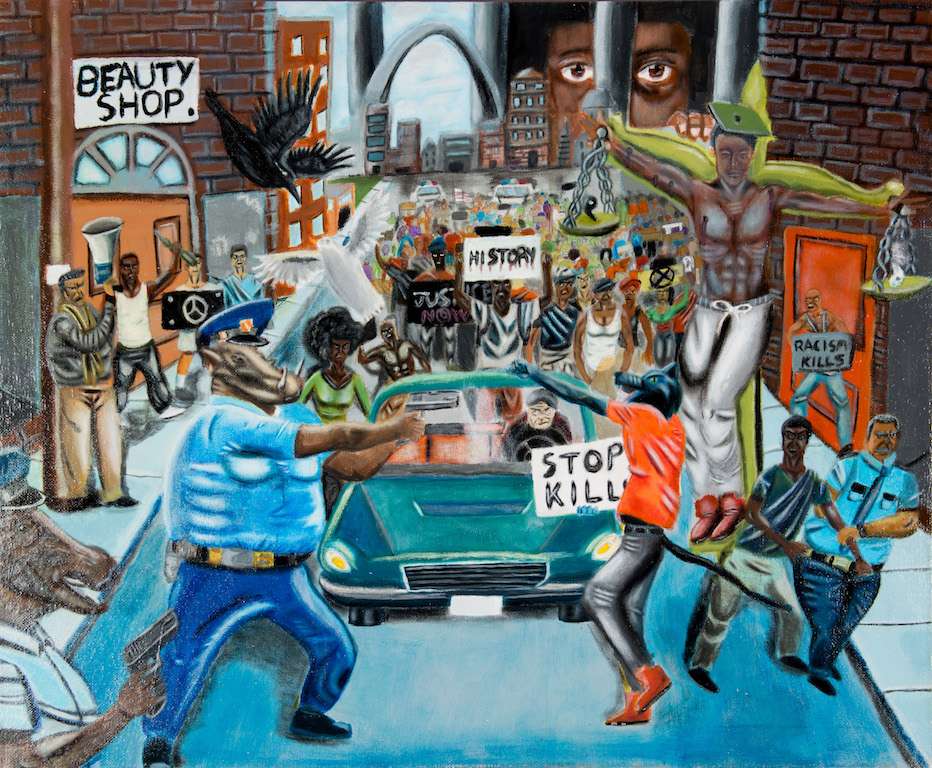The Volokh Conspiracy
Mostly law professors | Sometimes contrarian | Often libertarian | Always independent
How a high school student's painting caused congressional Republicans to act like campus snowflakes
A high school student's painting inspired by the police shooting and subsequent unrest in Ferguson, Mo., will be removed from the nation's Capitol next week because some members of Congress are offended by the artist's viewpoint. Specifically, some members of Congress believe the painting must be removed because it is "offensive" and "disrespectful" to law enforcement because it depicts police officers as "pigs."
The painting at issue (shown below) was put on display as part of the annual Congressional Art Competition sponsored by the Congressional Institute. As part of this competition, each congressional office selects a painting from a high school student from within his or her district, and they are displayed along a hallway for the year. This picture, "Untitled #1" by David Pulphus, was put up with other winners in June. Other paintings in the competition displayed along the same hallway celebrate military service and a soldier's return home. Some depict historical injustice, and others are overtly patriotic. (All the paintings from the competition may be found here.)

There was not much controversy about the painting until conservative commentators began noting it in December - some six months after the painting was put on display. These commentators, and some members of Congress, objected that the painting was offensive and disrespectful to law enforcement, and to Capitol Police officers in particular, who must work nearby. As Rep. Dave Reichert (R-Wash) commented, "It is disheartening to see this depiction of law enforcement hanging in the hallway of our nation's Capitol where officers work everyday to protect our safety and freedoms."
Not content to criticize the painting or celebrate law enforcement officers, some members of Congress called for the painting's removal. Rep. Duncan D. Hunter (R-Calif.) went further, taking it upon himself to physically remove the painting from the wall. The painting's sponsor, Rep. William Lacy Clay (D-Mo.), restored the painting, only to have it removed again by someone else. As the controversy grew, members of Congress appealed to the House leadership and to the Architect of the Capitol, to ensure that the painting would be permanently removed.
Like self-righteous college students, some members of Congress seem to believe that just because a work of art or other expression is "offensive, " it should be suppressed. While there is no First Amendment right to display art in the Capitol, it is a bedrock First Amendment principle that expression must not be suppressed because of the viewpoint expressed - and that is precisely what is occurring here. That police officers and others are offended by the painting is understandable, but that does not excuse efforts to censor its message.
In deciding the painting must be removed, the Architect of the Capitol cited rules prohibiting "exhibits depicting subjects of contemporary political controversy." There is a fair argument that the painting violated this rule, insofar as it focused on conflict between police and people of color and was motivated by the police shooting in Ferguson. Yet if that were the issue, one would have expected the architect to refuse to post the painting in the first place when this year's finalists were first put on display. Instead, the painting hung there for months, unremarked upon until some folks sought to stir up controversy, as have other paintings that have subtle political content, such as this depiction of President Obama and others with patriotic themes noted above. This painting was targeted because of its specific message, not because it is too political. As has been clear from the beginning of this controversy, the objections to this painting center on the painting's message - the viewpoint it appears to express - and nothing else.
On Thursday, someone placed a "Blue Lives Matter" flag on the wall above the painting. Whether or not such an impromptu display is allowed under the Capitol's rules, this is a much more appropriate response than stealing the painting from the wall or otherwise seeking to have it removed. Displaying the Blue Lives Matter flag is a way to express disapproval of the painting's message and endorse a counter-message. It is, in short, responding to potentially offensive speech with more speech. It is exactly what conservatives (and others) tell college students to do when they are confronted by speech that offends them, whether it's an art installation or a speech by an Internet provocateur.
Let me reiterate that I understand why some people find this painting to be particularly offensive, and I have no problem with members of Congress or others expressing that point of view. Insofar as some believe police officers often get a bum rap - in Ferguson or elsewhere - they should explain why this is so. They should not seek to censor or suppress the messages with which they disagree.
It's distressing when easily offended college students demonstrate a lack of awareness of First Amendment principles and the importance of free speech and open discourse. It is even more disheartening, however, when our elected representatives - those who take an oath to preserve and protect our Constitution - follow suit.
[Note: As originally published, this post misidentified Rep. Reichert. He represents Washington State, not California. I regret the error.]




Hide Comments (0)
Editor's Note: We invite comments and request that they be civil and on-topic. We do not moderate or assume any responsibility for comments, which are owned by the readers who post them. Comments do not represent the views of Reason.com or Reason Foundation. We reserve the right to delete any comment for any reason at any time. Comments may only be edited within 5 minutes of posting. Report abuses.
Please to post comments
Mute this user?
Ban this user?
Un-ban this user?
Nuke this user?
Un-nuke this user?
Flag this comment?
Un-flag this comment?